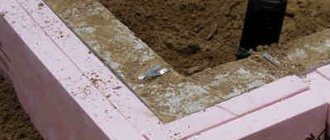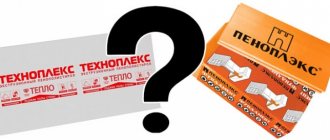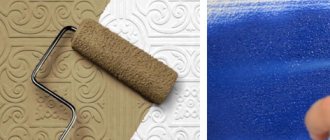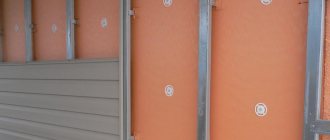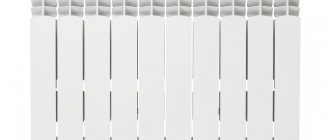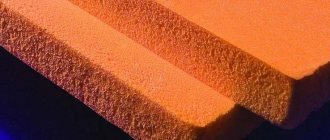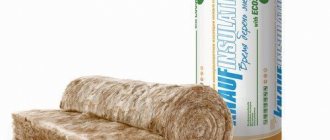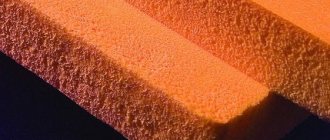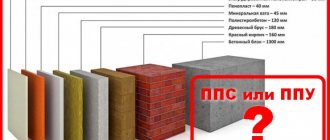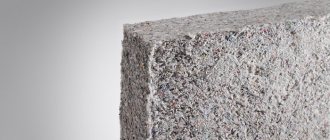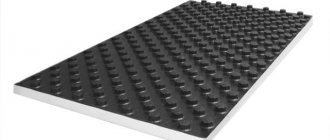Modern construction of buildings and structures for various purposes is not possible without the use of effective insulation materials, which make it possible to create reliable thermal protection of buildings and structures. Extruded polystyrene foam used for these purposes makes it possible to create reliable thermal insulation of premises, which helps to increase living comfort. The available opportunity to purchase technoplex penoplex in Kirishi and analogues produced by other manufacturers allows the buyer to make a choice based on financial capabilities and region of residence. Here you can find out where to buy penoplex in Perm.
Heat insulator brand Comfort properties and characteristics
Penoplex "Comfort" is a modified and improved "Penoplex 31C" with universal characteristics.
The material is actively used for insulating country houses, country houses and cottages. The high speed of installation and minimal labor costs popularize the insulation among private homeowners - it is used to insulate the subfloor, foundation and basement of a house, basement and roof, walls and partitions from the inside and outside of the building. Penoplex "Comfort" has high levels of moisture resistance and thermal conductivity. In the penoplex series line, the Comfort brand is recognized as universal. Penoplex protects the soil from heaving when it freezes - when the soil is insulated with this material, the freezing point of the soil will rise. This series is optimal for insulating road and railway surfaces, runways and technical areas of airfields. Comfort slabs retain their unique characteristics throughout the entire period of operation. Characteristics of the “Comfort” penoplex insulation brand are in the table below:
It is a misconception to think that penoplex and foam plastic are brother materials. Some properties of penoplex can be equated to the parameters of polystyrene foam, but not flammability and water absorption.
Manufacturers have long mastered the production of both non-flammable polystyrene foam and high-burning polystyrene foam. But the truth is that penoplex cannot spontaneously ignite, and in an open fire zone it will only melt, releasing carbon monoxide (CO) and carbon dioxide (CO 2) gases. If the fire is extinguished, the penoplex will not even smolder.
When choosing the thickness of expanded polystyrene sheets that will be used to insulate a building, it is important to take into account the climatic characteristics of the region where it is located, the dimensions of the building and the material from which it is built. There are two operational and technological characteristics that directly affect the quality of insulation of polystyrene foam - thickness and density
There are two operational and technological characteristics that directly affect the quality of insulation of polystyrene foam - thickness and density.
In general, sheets with a thickness of 50 mm and a density of 25 kg/m3 are considered optimal. This is the type of material that is usually recommended to developers or repairmen who do not know what thickness of polystyrene foam to insulate a house. However, the specified thickness and density are not an inviolable standard and may vary depending on the specific conditions indicated above.
Styrofoam or penoplex
A line of materials used for insulating three-layer walls, flat and pitched roofs, plinths, and underground parts of a building. Also used in the manufacture of sandwich panels, on highways and airfields.
Strength – 250-500 mPa;
Flammability group – G3 or G4;
Water absorption – 0.2%;
Vapor permeability – 0.006 mg/(mh*Pa).
Penoplex Roofing properties and characteristics
Penoplex insulation of the “Roofing” series is a renamed material “Penoplex 35”, which is recommended for use in insulating pitched and flat roofs of any design. The use of the “Roof” series makes the further operation of the roof as simplified as possible, since the reliability and long service life of the insulation minimize the possibility of repairing the roof surface. The popularity of this innovative insulating material is also due to the fact that greenhouses and summer gardens can be built on such a surface - such trends are now in fashion. Penoplex can withstand such high loads that it doesn’t care about soil loads of up to several tons. Characteristics of the foam insulation brand “Roof” are in the table below:
Eps insulation
This is a unique material that has the following properties:
- low water absorption, almost equal to zero;
- high strength;
- not subject to rotting;
- low thermal conductivity;
- high frost resistance;
- non-toxic to humans;
- easy to install;
- durability;
- light weight;
- environmental friendliness.
The disadvantages of polystyrene foam insulation include:
- strong flammability and intolerance to direct sunlight. This is important to know, because storing polystyrene foam in the sun can completely ruin the material, and this will be unpleasant ;
- Although manufacturers claim that polystyrene foam is not chewed by mice, consumer reviews show the opposite;
- And of course the price, which is quite high.
But what is the difference between Technoplex and Penoplex? What's better?
What to choose
If we compare these two insulation materials, then Technoplex is more technologically advanced and has better qualities, but the difference between it and Penoplex is so insignificant that it is impossible to say for sure which one should be chosen.
By choosing polystyrene foam insulation, regardless of whether it is Technoplex or Penoplex, you can get not only thermal insulation, but also sound and vapor barrier.
Please note: the service life of extruded polystyrene foam boards is more than 50 years, which is a long time. . However, it is worth remembering that polystyrene foam is still a chemical insulation, not a natural one.
Therefore, when burned, it releases very corrosive substances
However, it is worth remembering that polystyrene foam is still a chemical insulation, not a natural one. Therefore, when burned, it releases very caustic substances.
Scope of application of the material
Traditionally, extruded polystyrene foam boards are used in industrial, civil and road construction. They have been used for a long time and very successfully in facade heat-insulating compositions with external plaster, in multi-layer panels, successfully combined with other materials: cement-bonded particle boards, for example, and analogues.
Thermal insulation of floor coverings
When insulating a floor using a wide variety of heat- and sound-insulating foamed polymer materials, specialists, as a rule, give preference to XPS boards, which is justified by their strength. When working, it is important to keep in mind that they must be placed on any flat and hard surface.
All joints of laid slabs must be glued with construction tape, and after that the surface is reinforced with a special mesh. An indispensable condition is the presence of an expansion joint 2 cm wide around the perimeter. If installation of a “warm floor” is planned, at this stage the installation of its system is carried out.
The next step is to apply a reinforced screed 4–5 cm thick and eliminate small cracks and irregularities, and then lay the floor covering. It is important to keep in mind that it takes at least 28 days for the screed to dry completely.
Roof insulation
The technology of roof insulation using slabs of extruded polystyrene foam depends on its shape - pitched or flat. In both the first and second cases, in order to avoid the accumulation of condensate, it is recommended to additionally use hydro- and vapor barrier materials. Increased humidity over time will inevitably lead to a decrease in thermal insulation boards and wood rotting.
There are several ways to insulate a roof using such slabs:
- flooring;
- mechanical fixation;
- gluing;
- installation in the sheathing.
In practice, as a rule, several methods are combined at once.
A pitched roof is usually insulated by installing sheet material between the rafters. Most often, at the design stage, the distance between them is selected based on the size of the slabs. To ensure more reliable fastening and sealing, dowels and sealants are used.
When insulating a flat roof from the outside, the slabs are laid, glued or secured with dowels, ensuring a tight fit.
Before this, the surface is cleaned, waterproofing and a vapor barrier membrane are laid. Then expanded clay is poured onto the slabs and cement mortar is poured.
Such a roof can be insulated from the inside without dismantling the existing structure. For this, as in previous cases, dowels or glue are used for fastening, and sealant is used to fill voids.
After installing the sheets, the ceiling is sheathed with finishing material.
Insulation of walls inside a building
In the construction of individual houses, XPS boards are successfully used inside frame walls, installing them between the internal and external cladding.
Thermal insulation of walls in apartment buildings is considered the most problematic. To avoid shifting the location of condensation to the inner surface, sealing is used. In this regard, experts recognize XPS boards as the best material. Installation of insulation includes several stages:
- Surface preparation: removing plaster, removing dirt, treating with antiseptics, priming.
- Applying and priming a new plaster layer
- Installation of the frame under the heat-insulating slabs, taking into account the need for a gap between the wall and the slab of 3 - 5 mm.
- Sealing joints.
- Plaster and decorative finishing.
Insulation of facades
To insulate external walls, as a rule, XPS boards with a thickness of at least 80 mm are used. Before starting to lay the heat insulator, the surface is carefully prepared - putty is applied, leveled, cleaned and primer is applied.
The heat insulator is secured using dowels and glue. The outside of the sheets is covered with mastic and primed. If plaster is to be applied in the future, then an additional layer of mastic is applied to the slabs, into which a special mesh is pressed.
The final operation is decorating the walls. For this purpose, fiberboard and particle boards, siding and other similar materials are used.
Insulation of foundations
With proper use, high-quality XPS boards can last in soils for up to 50 years. When getting started, it is important to consider some nuances:
- to insulate the vertical wall of a shallow strip base, it is enough to use extruded polystyrene foam with a compressive strength of 150 - 250 kPa;
- under the base of the foundation it is necessary to place an XPS plate that can withstand 250 - 400 kPa;
- when using an insulated Swedish stove, you need a heat insulator with a strength of more than 400 kPa. In addition, it is advisable to have slabs of increased size - this will allow you to quickly install the foundation and reduce the number of seams.
Before starting work on insulating the foundation, you should prepare the surface: clean concrete particles from adhering dirt, rub cracks and chips with a cement-sand mixture. The slabs are fastened differently in different cases.
The insulation is attached to the vertical wall of the foundation, which has a waterproofing layer, using a special spike with teeth. The use of dowels here is unacceptable, as the waterproofing will be damaged. Additionally, special mastic or adhesive foam is used. It is applied, retreating from the edge at least 2 cm, and then wait 10 minutes. Gaps larger than 2 mm must be foamed.
When insulating a monolithic slab foundation or the sole of a strip base, the XPS slab is laid loosely on a sand bed. In some cases, adjacent insulating boards are fastened together, but most often it is enough to just foam the seams.
How many bricks does Penoplex replace?
Tightening requirements for heat and energy conservation of building structures requires at least a twofold increase in the thickness of walls and ceilings. For brick and concrete walls this figure is 90 and 110 mm, respectively. The problem is solved by using perfect facade and foundation thermal insulation. So how much brick does Penoplex replace, and why is this material considered optimal for insulating almost any building structure?
The material is difficult to counterfeit, so the risk of purchasing a low-quality counterfeit is reduced to zero.
What properties of Penoplex determine the high level of consumer demand?
When choosing a material, its unique low thermal conductivity, light weight, simple installation and long service life are taken into account.
- New generation extruded polystyrene foam thermal insulation differs from polystyrene foam in its perfectly homogeneous structure, resistance to compression loads and other adverse external influences.
- For all its advantages, mineral wool has strict weight restrictions. Therefore, to insulate devices that do not have a sufficient safety margin, lightweight materials based on polystyrene foam are used.
The disadvantages of Penoplex Facade, which you can buy from our company at any time of the year - zero vapor permeability and fairly low heat resistance, are partially or fully compensated by the use of façade systems with slot ventilation and the installation of heat-resistant protective and decorative coatings.
As for the insulation of underground structures, including foundation ones, in this case moisture- and frost-resistant polystyrene foam does not have a worthy alternative.
The strength of the foundation lining is sufficient to protect the waterproofing from damage by seasonal movements of heaving soils. The range of polystyrene foam insulation includes panels of different sizes: from 30 to 100 mm thick. In most central regions, panels with a thickness of 50-60 mm are in high demand. You can buy Penoplex 50 mm in Moscow with significant discounts at promotional and seasonal sales of building materials.
How much brickwork does Penoplex take?
For those who plan to order Penoplex, the ratio of thermal insulation material to brick plays an important role. We will tell you about the most popular thickness of thermal insulation boards and their correspondence to the thickness of the brickwork.
- Penoplex 20 mm replaces a brick wall with a thickness of 370 mm - this is almost 40 cm, that is, 2 times the thickness of the insulation itself. If you wanted to purchase reliable thermal insulation, but you were only stopped by ignorance of how much brick a 2 cm thickness of Penoplex replaces, today you learned an additional plus in the piggy bank of this material!
- How much does Penoplex 30 mm replace brickwork? Based on the data on the correspondence of 2 cm of insulation to a brick wall, it turns out that Penoplex 30 mm replaces as much as 555 mm of brickwork in terms of energy efficiency. Here is your answer to how many bricks 30 mm thick Penoplex replaces!
- What brick thickness does Penoplex 50 mm replace? A pleasant surprise awaits you! The technical characteristics of Penoplex 50 mm in comparison with brick will conquer not only the homeowner, but also the experienced developer. Brickwork 925 mm thick can be compared with 50 mm Penoplex - that’s how many bricks this insulation replaces!
Now that you have found out what wall thickness Penoplex replaces, there is no reason to put off the purchase of thermal insulation material - call us and order insulation at a favorable price today!
Expanded polystyrene insulation in country and cottage-type houses
Many developers use the material for external insulation of facades and ceiling structures of country houses, which are being converted for year-round living. The main range of applications for polystyrene foam insulation is finishing foundations, blind areas, and insulating cement screeds under floor tiles.
Unlike mineral wool, expanded polystyrene does not require film or mastic waterproofing, so it can be mounted directly on a flat ground surface.
The more than moderate cost of polystyrene foam materials is complemented by the possibility of do-it-yourself installation, which allows you to reduce the cost of thermal insulation work by 35-40%.
Buy high-quality Penoplex insulation from our company right now at a competitive price!
Differences between XPS and EPS polystyrene foam
There are 2 types of expanded polystyrene: extruded (XPS, eXtruded PoliStyrene) and foamed (EPS, Expanded PolyStyrene). In terms of chemical properties and thermal conductivity, the materials are very similar to each other, but some of their properties are fundamentally different:
- Compressive strength.
It is higher for XPS, but this is not important in all cases. Engineers determine the required strength. For most projects, EPS is sufficient, which allows you to save money on the budget, but for work with the foundation, XPS is still recommended, since it requires high-performance thermal insulation.
- Moisture retention.
Another argument in favor of using XPS for insulating the foundation and the soil around it (to prevent freezing), since this material does not absorb water. It is recommended to exclude the use of EPS in such cases. It has low water absorption (2%), but in the case of insulation of the foundation this can be critical. Soil in direct contact can cause the EPS to deteriorate over time.
- Insulating ability.
EPS has exactly the same vapor permeability as wood, and wooden houses are considered the most favorable in terms of microclimate. The XPS cannot boast of such properties. When insulating the walls in the house with it, the humidity slightly increases and the air exchange decreases. In this regard, when carrying out interior work, XPS is most popular in cases where it is necessary to reclaim square meters, for example, on a loggia. Here, the use of XPS will eliminate dampness of the walls and provide the required degree of thermal insulation without increasing its layer.
What to buy
The building materials market offers a huge selection of polystyrene foam boards. The high thermal conductivity of insulation boards depends on their type. For example: a sheet of polystyrene foam PSB-S 15 has a density of up to 15 kg/m3 and is 2 cm thick. For a sheet from 2 to 50 cm, the density is no more than 35 kg/m3. When comparing polystyrene foam with other similar materials, you can easily trace the dependence of the thermal conductivity of polystyrene foam boards on its thickness.
In order to apply one of the insulation methods, it is necessary to select the correct dimensions of the material. The following algorithm can be used to calculate:
- It is necessary to clarify the overall thermal resistance. This value depends on the region in which the calculation needs to be performed, namely on its climate.
- To calculate the thermal resistance of a wall, you can use the formula R=p/k, where its thickness is equal to the p value, and k is the thermal conductivity coefficient of the foam.
- From constant indicators we can conclude what resistance the insulation should have.
- The required value can be calculated using the formula p=R*k; the value of R can be found based on the previous step and the thermal conductivity coefficient.
What is the difference between the materials
Penoplex and Technoplex are similar thermal insulation materials. The main difference between them is the selling price
- Some differences in the performance properties of Penoplex and Technoplex are due to slightly different production technology and different methods of cooling the extruded material. According to the manufacturer TechnoNIKOL, Technoplex is produced without the use of freon mixtures.
- Adding various additives that enhance the properties of insulating boards. Technoplex is distinguished by the presence of graphite nanoparticles in its composition, which increase the overall strength of the material.
- The mechanical bending strength of Penoplex can reach 0.7 Pa compared to the average value of 0.3 Pa for Technoplex. It must be taken into account that these are serious values; both materials can withstand normal loads perfectly.
- The declared operating temperature of Penoplex starts from -70°C, TechnoNIKOL guarantees the preservation of the properties of its product at a temperature of -50°C. The difference, of course, is significant, but for central Russia it is irrelevant.
- There is a slight difference in the price of these products, but it is not absolute and depends mainly on the region and manufacturing plant.
Thickness calculation
The heat transfer resistance R is tied to the thickness of the building structure, and its minimum value established by regulatory documents varies depending on the climatic conditions in the region. For example, in the southern regions of the Russian Federation, the walls of residential buildings must have a heat transfer resistance of at least 2.1 m 2 °C/W. It is proposed to take this value as a basis and calculate how much brick and Penoplex will be needed to comply with it. The minimum indicator is calculated using the formula:
δ=Rxλ, where:
- δ—thickness value of the wall structure, m;
- λ is the thermal conductivity of the material from which the wall is built, W/m 2 °C.
- R is the heat transfer resistance, in the example it is 2.1 m 2 °C/W.
If we take the thermal conductivity coefficient of ordinary brickwork λ = 0.7 W/m 2 °C, then in the southern regions of the Russian Federation the thickness of walls made of ceramic products should be: δ = 2.1x0.7 = 1.47 m.
The same wall, but made of Penoplex with a density of 30 kg/m 3, will have a thickness: δ = 2.1x0.037 = 0.077 m, or 77 mm.
The difference between the materials will be 1.47/0.077=19. The brickwork must be so many times thicker than the expanded polystyrene layer in order to achieve the same thermal insulation value of the building. The full picture, showing a comparison of different types of brick walls and polymer insulation, is reflected in the table:
Now the table clearly shows how much worse the thermal conductivity of a brick wall differs from extruded polystyrene foam.
//www.youtube.com/watch?v=Fiv2o06iaQs
Brick lacks thermal insulation properties, and Penoplex lacks load-bearing capacity. Together they will give an excellent result: it is enough to insulate a masonry of 1.5 hollow pieces with 50 mm expanded polystyrene sheets, and the total cross-section of the fence will be only 0.43 m.
Due to the fact that the range of insulation materials presented on the building materials market is very large, each consumer can choose the type of insulation that is suitable for him.
One of these insulation materials is penoplex.
This is a synthetic insulating material for internal and external insulation.
Extruded polystyrene foam
Penoplex is a tile insulation made from extruded polystyrene foam. Unique thermal insulation characteristics are achieved thanks to the smallest cells filled with air.
Penoplex has a bright and recognizable orange color. Penoplex has excellent chemical resistance, but it is important to know that it is absolutely not resistant to gasoline (just like Technoplex). Due to its good strength properties, Penoplex can be used for external insulation.
There are different types in the Penoplex line (their names speak for themselves):
- roofing (insulation of attics and roofs of various configurations);
- wall (basement, walls, partitions, facade are insulated);
- foundation (used as insulation for the basement and floor of the first floor);
- comfort (can be used for any work, but is especially well suited for insulating apartments and balconies);
- 45 (has the best characteristics of all types, used in road construction and bridge construction).
. Penoplex is available in standard width and length - 600 mm by 1200 mm, respectively. But the thickness varies - from 20 mm to 150 mm.
Penoplex is used at temperatures from -50 0 C to +75 0 C. Water absorption - 0.4% - slightly worse than Technoplex, but still a very high figure. Thermal conductivity is 0.03 W/(m*K).
Comparison by main parameters
Mineral wool has a coefficient of 0.032-0.046, while penoplex has a coefficient of 0.03-0.032. The lower the indicator, the better, because there is less heat loss and the temperature inside the room is better maintained.
Penoplex is a fairly hard material that does not rot, dry out or crumble. The insulation has a long service life under the correct storage conditions, when it is reliably protected from prolonged sunlight and excessive heat. Mineral wool also does not dry out. Without exposure to high physical stress, it can last for a long time, is not afraid of high or low temperatures and long exposure to sunlight on the surface.
It is not at risk of mold and other harmful organisms, and it is also not susceptible to destruction by rodents. But mineral wool can crumble and settle on the wall. In general, both materials have an enormous service life, lasting at least 50 years.
Environmentally friendly.
Both materials are manufactured without the use of any hazardous components that could be harmful to human health, but still require absolute containment to protect the respiratory tract.
When insulating a perfectly smooth surface, work using penoplex is carried out much faster. It is lightweight, easy to cut and sand, and with an L-shaped edge, it eliminates the formation of cold bridges. When using it, there is no need to cover it with a vapor barrier. If there is no tongue-and-groove edge, then it is tedious to seal the seams or lay them in two overlapping layers, which will lead to unnecessary costs.
Mineral wool has a little more weight, but it is much more efficient and simplifies installation in existing heavy, disproportionate areas and structures. But when working with it, you must purchase special clothing in advance, along with a respirator and safety glasses.
If used to insulate the facade of a house, if the penoplex has a thickness of 50 mm, then the mineral wool should have a thickness of 60 mm to have a similar effect. The difference is not entirely dramatic. Depending on the situation, each of them is good in its own way, because cotton wool is capable of allowing air to pass through, unlike penoplex, which has an absolutely airtight structure.
Mineral wool absorbs water much more strongly, subsequently losing some of its thermal insulation characteristics. In this case, penoplex is significantly better, because even with intense and frequent rains, its mass will practically not change.
Mineral wool has the best performance in this parameter, because it is almost inflammable. Its melting point should be more than 1000°. Cotton wool contains an adhesive base that can ignite, but it occupies a very tiny part of the total volume of the material and does not pose a significant danger.
Penoplex is completely opposite in its qualities. It can melt and burn in open fire, releasing toxins that are very harmful to the human body. To ensure a high level of protection of buildings from fire, penoplex is categorically unsuitable for use. For these purposes, the best and unconditional option is mineral wool.
The price of materials is practically no different. There may be a slight difference only depending on the choice of the manufacturer.
What is extruded polystyrene foam
This material belongs to the category of foamed polymer heat insulators. Otherwise it is called XPS (Extruded Polystyrene Foam). In Russia, the technical conditions for their production are regulated by GOST 15588-2014.
It differs from other materials of this type, first of all, in its unique structure, due to which its physical and mechanical properties are noticeably superior to other representatives of this “family”. The structure, in turn, is provided by a special production technology - extrusion.
The term "extrusion" comes from the Latin word "extrusio", which translates as "pushing out". The essence of this operation is to press the polymer mass through a special hole - an extruder, as a result of which the structure of the resulting material is noticeably different from other foamed polymers in its reduced cell size (no more than 0.2 mm) and high density of their arrangement.
General information about properties and technical characteristics
Compared to traditional thermal insulation materials, foamed polymers have a number of advantages. For example, a ten-centimeter slab of such material is equivalent in thermal conductivity to wood 35 cm thick, as well as a wall made of solid clay brick 1.75 m thick or reinforced concrete 4.8 m thick. In this series, extruded polystyrene foam occupies a leading position in thermal insulation , strength and other properties.
Table 1. Physical and mechanical properties of extruded polystyrene foam
| Property | Averaged numerical value |
| Specific gravity | » 25 kg/m3 |
| Strength (compression) | ³ 0.2 MPa |
| Strength (bending) | ³0.35 MPa |
| Dry thermal conductivity | ³0.03 W/mK, |
| Water absorption over 24 hours, %, by volume | ≤ (0,15 – 0,2) |
| Vapor permeability | »0.011 mg/(m.h.Pa) |
What and how is the material made from?
The raw material for the foam material is granulated polystyrene. The technological process includes several operations:
- incoming control and warehousing;
- extrusion;
- calibration;
- pruning;
- cooling;
- formation of edges, grooves;
- final control;
- package.
After incoming quality control, the raw materials are placed for storage in cylindrical metal containers - silos, and then enter the extruder. This device is a shaft with nozzles designed for mixing and transporting the mixture.
At elevated temperatures, the granules melt. At this moment, gases (pentane, carbon dioxide and others) are introduced into the mass under pressure, causing an increase in the volume of the cells, as well as dyes, wetting agents and additional components. For example, fire retardants prevent the material from igniting, and a graphite additive helps to increase the service life of products. A “ribbon” of foam material is formed as it exits the slotted extruder die. The thickness of the product is set on the calibrator. At this stage, the material acquires a closed porous structure: the air is “closed” inside cells measuring 0.1 - 0.2 mm.
Then the workpiece is trimmed to give the primary geometric parameters of the slab. This technological operation is completed by cooling for 10 - 15 minutes.
The next stage is the formation of edges on a milling machine. During installation, this will ensure tight joining of the slabs and will prevent the formation of “cold bridges”. At this stage, special grooves for drainage are also applied to some types of slabs.
If it is necessary to obtain slabs of large thickness (up to 500 mm), they are glued into blocks of the required size. In the future, this will avoid multi-layer insulation.
Before packaging, samples from each batch are checked for compliance with the requirements of the standard:
- by thermal conductivity;
- compressive strength;
- water absorption;
- geometric parameters.
The formed blocks go to the packaging area, where the slabs are formed into pallets.
How safe and fire resistant is extruded polystyrene foam?
The resistance of building thermal insulation materials to fire is the most important safety indicator. GOST 32310-2012 establishes the constancy of fire-technical characteristics for the entire service life of the panels and defines several indicators by which they are assessed:
- flammability;
- flammability;
- smoke formation
Tests carried out by the Ministry of the Russian Federation for Civil Defense and Emergency Situations showed that all known foamed polymers belong to the group of normally combustible materials G3 according to GOST 30244-94. This means that after the fire source disappears, the stove can burn for up to 5 minutes. In the event of a fire, they will be damaged by 85% of the length and 50% of the mass. Based on GOST 30402-96, extruded polystyrene foam belongs to groups B3 and B2, that is, the material is moderately flammable. The smoke generation coefficient according to (D3) and the degree of their toxicity (T3) are assessed by regulatory documents as high. Taking this into account, when installing insulating structures, it is recommended to refer to special Recommendations that were developed by the Russian Ministry of Emergency Situations.
Advantages and disadvantages
Compared to mineral heat insulators, foamed polymer insulation has a number of advantages:
- low specific gravity;
- resistance to mold, rodents, etc.;
- minimal water absorption – 50–60 times less than that of basalt wool;
- low vapor permeability and thermal conductivity (25% less than mineral wool);
- ease of installation - fastened using self-tapping screws or plastic products;
- safety in operation - lightweight, does not emit harmful dust when sawing.
Having all of the above advantages, polystyrene produced by extrusion differs markedly from other representatives of foamed polymers in terms of strength and water absorption.
For example, a square meter of extruded polystyrene foam retains its thermal insulation properties when wet once 100% and can withstand a load of 35 tons (for comparison: expanded polystyrene foam can withstand a load of up to 25 t/m2).
The disadvantages of foamed thermal insulating polymer materials include:
- the need to prepare a flat and smooth surface during installation;
- fragility, brittleness under the influence of significant mechanical influences;
- destruction under direct influence of ultraviolet radiation;
- decrease in heat-protective properties with prolonged exposure to moisture.
However, if the slabs, when installed correctly, were protected from sunlight, condensation, precipitation, and the structure was equipped with ventilation, the service life of the material will be at least 50 years.
Answers from experts
Engineer:
Both brick and foam are different.
Formally, the thermal conductivity of red brick is 10 times greater than that of highly porous foam. (0.56 and 0.05 W/m*deg - respectively)
That is, feel free to multiply the thickness of the foam by 11 and get the thickness of the brick wall.
Kirill Gribkov:
none
Bolt-gnawer:
Extruded polystyrene foam "Extraplex" with a thickness of 20 mm is equivalent in its heat and sound insulating properties to a brick wall with a thickness of 370 mm
Samson Altunyan:
Hello, the best!
You forgot to mention the conditions (parameters) of the assessment...
1) If you mean thermal conductivity? . The engineer answered you.
2) If we are talking about mechanical strength? . Polystyrene foam is NOT a replacement for brick. Especially in earthquake-prone regions.
3) Durability? The brick will last longer.
4) Resistance to environmental influences (temperature changes, humidity, etc.)? Foam plastic, in this case, is not even a building material...
5) Safety (physiological, chemical, environmental)?..Again, the comparison will be in favor of fired clay (brick)...
And generally speaking.. . That's not what they teach you... ;-( Foam plastic is NOT a good choice of material for construction or interior decoration. And in this ODIN is absolutely right...
Good luck to you!
Nurgaliev Marat:
5 cm of penoplex is half a meter of brick!!! And don't listen to the reindeer herders!
kukuzya:
I read the answers and I'm confused. What kind of tusk do you need to be in order to answer the question about the equivalence of brick and foam plastic and compare their load-bearing abilities... Of course, they compare thermal conductivity...
ST:
10cm of foam replaces 50cm of brick
Lulechka:
thickness is the same. in terms of strength, thermal insulation and other qualities - this is for builders!!!
Igor Chekalin:
Considering the beginning of winter, I suspect that we are talking about thermal conductivity?
Is the brick hollow or solid, silicate, ceramic, silica or even slag? The difference between different types is almost two times, and with silica it is 5 times.
For the worst case - solid sand-lime brick - the thickness ratio is approximately 20 times. That is, in terms of thermal conductivity, a 250mm wall (ordinary one-brick masonry) corresponds to only 13mm of polystyrene foam. For hollow bricks the ratio is ~10 times. That is, in our case - ~25mm foam. However, brickwork is almost airtight, and when insulated with foam plastic, there are gaps at the joints, loose edges, etc., so it’s not entirely correct to take such a formal and mathematical approach.
Well, more accurate numbers - google for “thermal conductivity table of building materials”
Alexander Kulikov:
The thickness of your knowledge of the Russian language...
Albert Belkov:
In fact: 1 cm of foam plastic in terms of thermal conductivity can be estimated as half a brick inside the masonry or backfill.
ST:
10cm of foam replaces 50cm of brick
General comparative characteristics
If you still can’t decide whether technoplex or penoplex is better, you should definitely read reviews about these materials before purchasing
However, it is equally important to familiarize yourself with the main technical characteristics
For example, experts advise paying attention to the area of use
Penoplex is intended for internal, external and roofing thermal insulation; this material is also excellent for road work. Technoplex, in turn, is used for work on internal insulation of residential premises. Graphite acts as additional additives for the first mentioned material, while for the second insulation their role is played by fire retardant additives, which applies to all series used for thermal insulation of walls. The density of the material is approximately the same, for example, for penoplex this indicator varies from 25 to 47 kilograms per cubic meter, while for the opponent it is from 26 to 35 kg per cubic meter.
If you haven’t decided whether technoplex or penoplex is better, it is recommended to read the reviews in advance, they echo the characteristics presented in the article
Many consumers pay attention to how flammable the material is. Both materials belong to class G4, which indicates a lack of resistance to direct fire
When there is such a large assortment of different products on the building materials market, it is difficult to understand and choose the right one. Thermal insulation materials are no exception, because each type of insulation has its own special properties and characteristics. The difficulty lies in the fact that it is necessary to choose the type that will satisfy all the requirements most accurately for the insulation of certain objects.
There is a great demand for tile insulation and, among a large range of products, technoplex and penoplex are often purchased, as they have proven themselves to have positive qualities. To figure out which one to give preference to, it’s worth comparing the main characteristics
these two popular insulation materials.
Operational and technical properties of penoplex, advantages and disadvantages
- Thermal conductivity – 0.03 Wm·0 C, the indicator does not decrease even with strong humidification;
- Water resistance – 0.4-0.6% when immersed in water for 24 hours and for a month;
- The vapor permeability of the material can be compared with the same indicators of roofing felt with a layer thickness of 20 mm;
- Chemical passivity: penoplex does not react to contact with building mortars and most aggressive substances. Substances with which penoplex contact is contraindicated: kerosene, acetone, formaldehyde, benzene, xylene, toluene, formaldehyde, methyl ethyl ketone, ether, diesel fuel, gasoline, tar, paints and epoxy resins;
- High mechanical resistance to stretching, compression, tensile forces and multi-vector pressure. The compressive strength of penoplex is 0.2-0.5 MPa;
- Biological neutrality - penoplex does not develop mold, does not decompose and does not rot;
- Wide range of operating temperatures - from -50 to +75 0 C. The temperature range for each brand is indicated on the packaging;
- Flammability groups for different brands are different, from G1 to G4, depending on operating conditions;
- Environmentally friendly material without the use of phenols and freons in the production;
- Guaranteed service life ≥55 years without noticeable loss in properties.
Advantages of penoplex:
- Thermal conductivity properties make it possible to use penoplex even in the Far North - multiple freezing/thawing cycles of the material do not affect its characteristics;
- Light weight makes transportation, warehousing, storage and insulation of the object easier, allows you to lighten the foundation and not strengthen the ceilings;
- Simple installation without the help of specialists and special tools - penoplex can be easily cut with a regular hacksaw or cutter;
- Safety and environmental friendliness - you can work with the material without personal protective equipment;
- Low cost of all brands of insulation. Even with a large consumption of heat insulator, the costs of its purchase and installation pay off in 2-3 seasons.
Disadvantages of penoplex:
- Low fire safety - material of any flammability group, even with fire retardant additives, can catch fire and release caustic toxic smoke;
- Low coefficient of vapor permeability, and under certain weather conditions - negative. Therefore, it is not recommended to use penoplex for internal insulation of house walls. To maintain optimal operating conditions for the insulation, it is necessary to provide forced-air ventilation in the house and ventilation of channels in walls insulated with penoplex;
- Destruction of the material when exposed to ultraviolet radiation - sunlight. It is necessary to protect the insulation layer with plaster or other methods;
- Due to the smooth surface, the adhesion of penoplex to mortars is quite low, so the insulation should only be attached to dowels or special expensive glue, but not to mortars.
The main features of high-quality extruded polystyrene foam
The main parameters that indicate product quality are regulated by GOST 15588-2014. They can only be fully tested in laboratory conditions.
Meanwhile, some indicators, and, first of all, the structure, can be assessed independently. To do this, you need to cut a piece of slab with a sharp knife and carefully examine the cut.
High-quality material has a uniform fine-cell structure.
Non-compliance with the requirements of the standard is indicated by the presence of pores and cells that are visible to the naked eye. Such a stove will not last more than three years.
You can also check the strength properties without special equipment. It is enough to press your finger firmly on the sample.
If the material is defective, you will hear a cracking noise made by collapsing cells. High-quality material can easily withstand such a load without damage.
To assess the level of water absorption, two samples should be placed in water for a day. After this time, you need to place the products on a napkin and press on each of them. A puddle will form around defective polystyrene foam, while quality polystyrene will only slightly moisten the fabric.
How much Penoplex will replace a brick wall?
How much does Penoplex brick replace? The latter is not the name of the building material. This is what one of the most popular brands producing polymer thermal insulation boards sounds like. Here we mean extruded polystyrene foam, one of the best insulation materials that currently exists. It is worth understanding in what respect it can be compared with brick.
Clarification of terms
First of all, you need to understand to what extent expanded polystyrene can replace brickwork. These are completely different building materials.
Considering that both materials take part in the construction of external walls of buildings, only one comparison is appropriate between them - in terms of thermal conductivity. It is this characteristic that is meant when posing the question, but it needs to be reformulated correctly: what thickness of Penoplex and brick will create the same thermal resistance. In terms of other characteristics, the comparison is not in favor of the polymer.
Thermal conductivity indicators
The ability to resist the passage of thermal energy flow is characterized by the thermal conductivity coefficient λ, expressed in units of W/m 2 °C. As a rule, sellers of various insulation materials provide the value of this coefficient for products in a dry state. At the same time, regulatory documents require calculations to be made based on real operational indicators, the values of which are not so impressive.
The materials in question are available in several varieties. Brick is made from different materials and using different technologies. Brands of extruded polystyrene foam differ in density, which affects its thermal conductivity. Operating thermal indicators for products of different types look like this:
The list shows values for finished brickwork built with cement-sand mortar. For other types of solutions, the indicators will be slightly different. The characteristics of extruded polystyrene foam of different densities are strikingly different:
- Penoplex density 30 kg/m 3, λ=0.037 W/m 2 °C,
- the same, density 50 kg/m 3, λ=0.038 W/m 2 °C.
It is noticeable how much less the thermal conductivity of polymer insulation is than that of a brick wall. But these numbers are abstract and therefore difficult to understand for the average person. To understand the situation, we need to bring all the indicators to one concept - thickness. To do this, it is necessary to determine one more characteristic - heat transfer resistance R, expressed in units of m 2 °C/W.
Thickness calculation
The heat transfer resistance R is tied to the thickness of the building structure, and its minimum value established by regulatory documents varies depending on the climatic conditions in the region. For example, in the southern regions of the Russian Federation, the walls of residential buildings must have a heat transfer resistance of at least 2.1 m 2 °C/W. It is proposed to take this value as a basis and calculate how much brick and Penoplex will be needed to comply with it. The minimum indicator is calculated using the formula:
- δ—thickness value of the wall structure, m,
- λ is the thermal conductivity of the material from which the wall is built, W/m 2 °C.
- R is the heat transfer resistance, in the example it is 2.1 m 2 °C/W.
If we take the thermal conductivity coefficient of ordinary brickwork λ = 0.7 W/m 2 °C, then in the southern regions of the Russian Federation the thickness of walls made of ceramic products should be: δ = 2.1x0.7 = 1.47 m.
The same wall, but made of Penoplex with a density of 30 kg/m 3, will have a thickness: δ = 2.1x0.037 = 0.077 m, or 77 mm.
The difference between the materials will be 1.47/0.077=19. The brickwork must be so many times thicker than the expanded polystyrene layer in order to achieve the same thermal insulation value of the building. The full picture, showing a comparison of different types of brick walls and polymer insulation, is reflected in the table:
What is better to insulate with stone wool?
Mineral wool is well suited for buildings that are built from breathable materials, for example, wood or brick. In general, it combines well with all coatings, and has no exceptions.
According to some indicators, materials differ specifically, and their choice should be made based on the conditions in which they will be located. It is almost impossible to say which of them is better, because each of them is good in its own way.
Expanded polystyrene panel thermal insulation has significant reserves for further improvement. The range is updated through the development of new materials and the refinement of existing models that are in high consumer demand.
Buyers managed to appreciate the obvious and hidden advantages of extruded polystyrene foam, which meets the basic requirements of modern technologies.
New for the season is Technoplex, which is positioned by manufacturers as a material with additional performance properties. This information contains the comparative characteristics of standard polystyrene foam and its improved version - Technoplex.
Density
When answering the question of how penoplex differs from technoplex, it is important to pay attention to the density of each. This property is an important characteristic for insulating materials. The degree of resistance to various types of influences and the ability to retain heat depend on the density.
Both materials are available in several types. Penoplex sheets are manufactured with a density of 28-47 kg/m3, and technoplex sheets are manufactured with a density of 25-45 kg/m3.
The degree of resistance to various types of influences and the ability to retain heat depend on the density. Both materials are available in several types. Penoplex sheets are manufactured with a density of 28-47 kg/m3, and technoplex sheets are manufactured with a density of 25-45 kg/m3.

